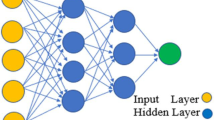Abstract
This study examined the effective network architecture to discriminate oil spills from look-alikes using deep learning-based semantic segmentation. Data were collected from three different SAR satellites, ENVISAT, ALOSPOLSAR, and TERRASAR. To ensure better accuracy, different characteristics of SAR satellites were analyzed based on spatial and temporal resolution. Semantic segmentation helps in finer inference by making dense predictions from labels of each class. Before entering into the segmentation phase, image preprocessing is done for effective segmentation results. The image Preprocessing phase includes log normalization, hybrid median filter, and scaling. Oil spill discrimination is done by Semantic segmentation using CNN and deeplabv3plus with pretrained RESNET18 on three different satellite images with the high-level and low-level dataset. It is observed that a high-level dataset of TERRASAR images outperforms rather than another SAR dataset. The comparison technique reveals that the proposed DeeplabV3plus segmentation has resulted in a great accuracy of 99% and is considered as the effective segmentation technique for oil spill discrimination.
Access this chapter
Tax calculation will be finalised at checkout
Purchases are for personal use only
Similar content being viewed by others
References
Chen, L.C., Barron, J.T., Papandreou, G., Murphy, K., Yuille, A.L.: Semantic image segmentation with task specific edge detection using CNNS and a discriminatively trained domain transform. In: IEEE Conference on Computer Vision and Pattern Recognition, pp 4545–4554 (2016)
Chen, L.C., Papandreou, G., Kokkinos, I., Murphy, K., Yuille, A.L.: Deep lab: semantic image segmentation with deep convolutional nets, atrous convolution, and fully connected CRFs. arXiv preprint arXiv:1606.00915 (2016)
Chen, L.C., Yang, Y., Wang, J., Xu Yuille, A.L.: Attention to scale: scale-aware semantic image segmentation. In: IEEE Conference on Computer Vision and Pattern Recognition, pp. 3640–3649 (2016)
Garcia-Garcia, A., Orts-Escolano, S., Oprea, S.O., Villena-Martinez, V., Garcia-Rodriguez, J.: A review on deep learning techniques applied to semantic segmentation. arXiv:1704.06857v1 [cs.CV] (2017)
Ilango, G., Marudhachalam, R.: New hybrid filtering techniques for removal of Gaussian noise from medical images. ARPN J. Eng. Appl. Sci. 6(2), 8–12 (2011). ISSN 1819-6608
Orfanidis, G., Ioannidis, K., Avgerinakis, K., Vrochidis, S., Kompatsiaris, I.: A deep neural network for oil spill semantic segmentation in SAR images. In: 25th IEEE International Conference on Image Processing (ICIP) (2018). https://doi.org/10.1109/icip.2018.8451113
Guo, H., Wei, G., An, J.: Dark spot detection in SAR images of oil spill using segnet. Appl. Sci. 8, 2670 (2018). https://doi.org/10.3390/app8122670
Topouzelis, K., Singha, S.: Oil Spill Detection: Past and Future Trends (2016). https://www.researchgate.net/publication/304496256
Zeng, K., Wang, Y.: A deep convolutional neural network for oil spill detection from spaceborne SAR images. Remote Sens. 12, 1015 (2020). https://doi.org/10.3390/rs12061015
Mohan1, E., Sivakumar, R.: Denoising of satellite images using hybrid filtering and convolutional neural network. Int. J. Eng. Technol. 7(4.6), 462–464 (2018)
Wurm, M., Stark, T., Zhu, X.X., Weigand, M., Taubenböck, H.: Semantic segmentation of slums in satellite images using transfer learning on fully convolutional neural networks. ISPRS J. Photogramm. Remote Sens. 150(2019), 59–69 (2019)
Krestenitis, M., Orfanidis, G., Ioannidis, K., Avgerinakis, K., Vrochidis, S., Kompatsiaris, I.: Oil spill identification from satellite images using deep neural networks. Remote Sens. 11, 1762 (2019)
Alif, M.A.R., Ahmed, S., Hasan, M.A.: Isolated Bangla handwritten character recognition with convolutional neural network. In: International Conference of Computer and Information Technology (ICCIT) (2017)
Garcia-Pineda, O., Holmes, J., Rissing, M., Jones, R., Wobus, C., Svejkovsky, J., Hess, M.: Detection of oil near shorelines during the deepwater horizon oil spill using synthetic aperture radar (SAR). Remote Sens. 9, 567 (2017). https://doi.org/10.3390/rs9060567
Ajadi, O.A., Meyer, F.J., Tello, M., Ruello, G.: Oil spill detection in synthetic aperture radar images using Lipschitz-regularity and multiscale techniques. IEEE J. Select. Top. Appl. Earth Obs. Remote Sens. 11, 2389–2405 (2018)
Sornam, M.: Oilspill: and look-alike spots from SAR imagery using OTSU method and artificial neural network. Int. J. Eng. Technol. Manag. Res. (2017). https://doi.org/10.5281/zenodo.1065293, ISSN 2454-1907
Yekeen, S.T., Yusof, K.B.W., Balogun, A.L: A novel deep learning instance segmentation model for automated marine oil spill detection, ISPRS J. Photogramm. Remote Sens. 167, 190–200 (2020)
Liu, X., Deng, Z., Yang, Y.: Recent progress in semantic image segmentation. Artif. Intell. Rev. (2018). https://doi.org/10.1007/s10462-018-9641-3
Yang, Y., Li, Y., Yang, Y., Ma, J.: Detection of oil spill and look-alike from SAR imagery based on ontology and kernel fuzzy C-Means. In: International Conference on Information Science and Control Engineering (2017). https://doi.org/10.1109/ICISCE.2017.64
Ghorbani, Z., Behzadan, A.H.: Identification and instance segmentation of oil spills using deep neural networks. In: 5th World Congress on Civil, Structural, and Environmental Engine (2020)
Author information
Authors and Affiliations
Editor information
Editors and Affiliations
Rights and permissions
Copyright information
© 2021 Springer Nature Switzerland AG
About this paper
Cite this paper
Sudha, V., Vijendran, A.S. (2021). Oil Spill Discrimination of SAR Satellite Images Using Deep Learning Based Semantic Segmentation. In: Chaubey, N., Parikh, S., Amin, K. (eds) Computing Science, Communication and Security. COMS2 2021. Communications in Computer and Information Science, vol 1416. Springer, Cham. https://doi.org/10.1007/978-3-030-76776-1_9
Download citation
DOI: https://doi.org/10.1007/978-3-030-76776-1_9
Published:
Publisher Name: Springer, Cham
Print ISBN: 978-3-030-76775-4
Online ISBN: 978-3-030-76776-1
eBook Packages: Computer ScienceComputer Science (R0)




